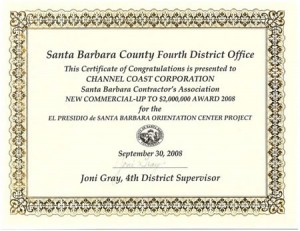Crypt opens for retrofit

BY EMILY PARKER, NEWS-PRESS STAFF WRITER
April 2, 2013 4:55 AM
With Easter lilies still adorning the altar at the Santa Barbara Mission, several construction workers opened the underground crypt and constructed a makeshift containment room in front of the pews Monday morning.
“Our little project is finally under way,” said Kristina Foss, director of the mission museum. “It’s been a long time coming. The whole point is to make this safe and last for the next 100 to 200 years.”
Crews started by lifting and removing the plaque, which covers the opening in the floor in front of the first row of pews. Then, they put a ladder down into the vault, built a containment room and removed the surrounding bricks and mortar to access the rusting support beams.
Since the 1920s, railroad rails for a trolley have helped support the 9-foot-by-8-foot atrium and the six adjoining burial vaults, Mr. Womack said.
However, the rails are rusting.
The new rust-resistant support beams being installed this week should easily last another 100 years, said David Wilks, project and business manager at the mission.
Mission staff decided to start construction the day after Easter because this weekend does not have a scheduled wedding, confirmation or other special event, Ms. Foss said.
Channel Coast Corporation Inc. staff will work double shifts — 7 a.m. to 11 p.m. — every day this week to finish in time for parishioners to attend the 4 p.m. Saturday Mass.
Ms. Foss said if construction workers find anomalies in building plans or materials, the project could take longer than anticipated and push into next week, which will be “hugely problematic.”
“The crypt was built in 1820, and there are no blueprints or plans,” she told the News-Press. “We’re hoping to have no nasty surprises, but in a building such as this, there can always be surprises.”
“Like most national landmarks, it’s old and fragile,” she added. “It needs constant monitoring.”
On site to monitor and make adjustments in case an unwelcome surprise pops up is the mission’s structural engineer Nels Roselund, the engineer who retrofitted the rest of the mission building in the 1990s.
When the crypt was opened at that time, “it was clear the floor was being held up by some severely rusted railroad rails,” Ms. Foss said. “Now, we’re getting this last piece of the church building appropriately stabilized. We’re trying to get every little minor thing taken care of.”
Before starting construction, workers built a containment room out of wooden-framed walls covered in thick, translucent plastic sheets, to help keep dust and debris off the church’s artifacts, paintings and tourists.
Since the crypt is an enclosed space, the U.S. Occupational Safety and Health Administration requires constant air-quality monitoring inside the containment room.
Renovating the crypt is one of several projects Mr. Wilks said he hopes to complete with a $650,000 matching grant the Mission received from the National Park Service’s Save America’s Treasures program. To receive the money, Mission backers must raise another $650,000 from private donations.
The drive is $300,000 short, Mr. Womack said.
President Barack Obama signed the Mission’s grant in January 2011, just 24 hours before the Save America’s Treasures program was cut, Ms. Foss said, adding the Santa Barbara Mission got the last grant awarded.
The Mission relies on federal grants and private donations because the Catholic Church does not have a fund dedicated to historic preservation.
“There is not a widespread need for historic preservation in the Catholic Church,” Ms. Foss said, adding each local bishop or dioceses is responsible for its own building upkeep.
Even though the crypt project was originally estimated to cost $100,000, the Mission likely will spend only half of that, she said.
By using a local construction and historic preservation firm, Mission officials saved the transportation, housing and food costs it would have paid for an out-of-town construction crew.
“It was substantially less using a firm from our local community,” Ms. Foss said. “We like to see work go to the community and (Channel Coast Corporation) had the best system to get the job done in the appropriate amount of time with (dust) containment.”
Rebuilt in 1820, the crypt holds the remains of historically important people, including Governor Jose Figueroa, the first Mexican-born governor of California, and Captain Jose De la Guerra y Noriega, commander of the Santa Barbara Presidio, Mr. Womack said.
Some of the descendants of people buried in the crypt still live in Santa Barbara.
The Santa Barbara Mission is the only California mission with a crypt because it served as the state’s cathedral in the 1830s and ’40s when the first bishop of California — Bishop Garcia Diego — resided in Santa Barbara.
Bishop Diego’s remains were buried in the wall of the church instead of in the crypt.
Tourists can still take tours and walk through the Mission all week.
“It’s not to stop any of the activity here but, to see the altar, (tourists) will have to come to one side or the other (of the containment structure),” Ms. Foss said.
While the work is being done, mass will be held in Serra Chapel at the Mission Renewal Center.
Tax deductible donations to the project can be made online at









